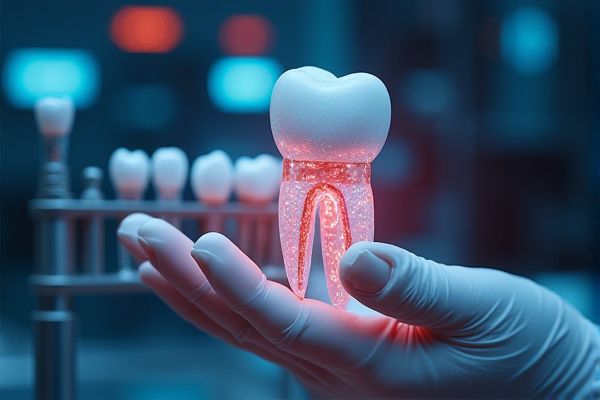
AI enhances diagnostic accuracy in dentistry by analyzing dental images, identifying cavities, and detecting early signs of oral diseases. Treatment planning benefits from AI algorithms that evaluate individual patient data, optimizing procedures and materials tailored to specific needs. Patient engagement improves through AI-driven apps that provide reminders for oral care routines and educational content on maintaining dental health. Predictive analytics powered by AI can forecast patient outcomes, leading to more informed decisions and proactive care management.
AI usage in dentistry
Diagnostic Imaging Enhancement
AI can enhance diagnostic imaging in dentistry by improving the accuracy of detecting dental conditions. For instance, algorithms can analyze X-rays to identify cavities or periodontal disease more reliably than traditional methods. The integration of AI tools like dental imaging software can lead to earlier interventions and better patient outcomes. Embracing technology in practices such as oral radiology may provide a competitive edge in patient care quality.
Predictive Analytics for Treatment Planning
AI usage in dentistry can enhance predictive analytics for treatment planning, allowing practitioners to make more informed decisions. By analyzing patient data, such as dental history and demographic factors, AI can predict potential issues and recommend preventive measures. For example, institutions like the American Dental Association are exploring AI-driven tools to streamline diagnosis and tailor treatment plans. This advancement may lead to better patient outcomes and more efficient use of resources in dental practices.
Automated Charting and Documentation
AI can enhance automated charting and documentation in dentistry, reducing the time practitioners spend on administrative tasks. For example, tools like Denti.AI can analyze X-rays and generate accurate patient records efficiently. This allows dentists to focus more on patient care, potentially improving treatment outcomes. The integration of AI also presents opportunities for improved data accuracy and reduced human error.
Virtual Treatment Simulation
AI usage in dentistry can enhance treatment planning by providing virtual treatment simulation. This technology allows practitioners to visualize potential outcomes, improving patient communication and satisfaction. For example, institutions like the University of Southern California utilize these simulations to educate students and refine techniques. The chance of improving procedural efficiency and patient understanding is significant as AI continues to advance.
AI-Powered Patient Monitoring
AI-powered patient monitoring in dentistry can enhance precision in treatment by analyzing real-time patient data. This technology enables dental professionals to detect potential issues early, improving patient outcomes. For example, AI algorithms can anticipate complications during procedures based on historical data. Implementing such systems may also optimize workflow, allowing institutions like dental clinics to manage resources more efficiently.
Personalized Oral Health Recommendations
AI usage in dentistry can enhance personalized oral health recommendations by analyzing patient data, such as dental history and genetic factors. For example, dental clinics like Aspen Dental could implement AI systems to tailor treatment plans for individual patients, improving outcomes. These advancements may lead to increased patient satisfaction and potentially lower overall treatment costs. The chance of better preventive care through individualized advice further showcases AI's potential benefits in the field.
Precision Dentistry
AI usage in precision dentistry can enhance diagnostic accuracy by analyzing imaging data for early detection of dental issues. Tools like machine learning algorithms can predict patient outcomes and tailor treatment plans based on individual needs. Incorporating AI into dental practices may improve efficiency, allowing dentists to focus more on patient care rather than administrative tasks. This technology could provide a competitive advantage for institutions like the American Dental Association by integrating advanced methodologies into their practices.
Workflow Optimization
AI technology can enhance workflow optimization in dentistry by streamlining patient management and appointment scheduling. For instance, tools like Dentrix can analyze patient data to predict appointment needs, reducing wait times and improving overall efficiency. Automating administrative tasks with AI may allow dental professionals to focus more on patient care instead of paperwork. This shift could lead to increased patient satisfaction and potentially higher retention rates in dental practices.
AI-Assisted Orthodontics
AI-assisted orthodontics offers significant potential for improving treatment outcomes and enhancing patient satisfaction. Technologies such as 3D imaging and machine learning can help predict tooth movement more accurately, leading to customized treatment plans. For example, institutions like Harvard School of Dental Medicine are exploring AI's role in creating Invisalign aligners tailored to individual patient needs. This integration of AI could streamline workflows and reduce the time patients spend in treatment.
Integration with Teledentistry
AI integration in dentistry may enhance diagnostic accuracy and patient management. For instance, teledentistry can leverage AI algorithms to analyze patients' oral scans remotely, offering preliminary assessments. This technology could improve accessibility, allowing more patients to receive consultations without needing to visit a clinic. The potential for timely interventions increases the likelihood of better treatment outcomes for dental conditions.
 techknowy.com
techknowy.com